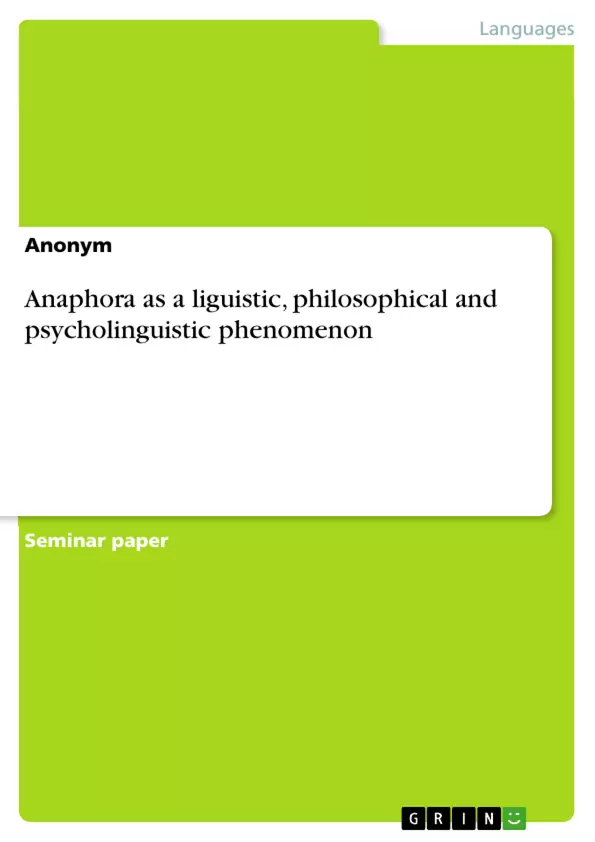In this paper I will try to examine how different academic fields approach anaphoric phenomena. The fields involved here are primarily philosophy and linguistics, with its subfields of semantics, syntax, and psycholinguistics. Especially in linguistics, Anaphora is traditionally thought of in opposition to deixis. Philosophy is not so much directly concerned with anaphora, but rather more generally with the processes of reference; however this larger discussion adds to an understanding of anaphoric processes too. Formal semantics, again, has developed a new dichotomy of bound anaphora versus referential ones - instead of the classical one between anaphora and deixis. Given these different approaches, I will try to find those within the two broad fields which seem to be best compatible. I will especially present one linguistic approach that might be compatible with at least one strand of the philosophical literature, and also with psycholinguistic insights into the matter. My hope is that Sag & Hankamer’s paper of 1984 fulfills these criteria and thus allows for an interdisciplinary view of anaphora.
Sag & Hankamer’s approach will however only be addressed later. First, I will give an oversight of what anaphora is supposed to mean linguistically and then go on to present what philosophy makes of the phenomenon.
Inhaltsverzeichnis (Table of Contents)
- Introduction
- Anaphora as a Linguistic Phenomenon
- Syntactic and Semantic Approaches to Anaphora
- Anaphora as a Philosophical Phenomenon
- Anaphora as a Psycholinguistic Phenomenon
- Sag and Hankamer 1976
- Sag and Hankamer's Approach
- Sag and Hankamer 1984
- Compatibility of Sag and Hankamer 1984 with Philosophical Approaches
- Conclusion
Zielsetzung und Themenschwerpunkte (Objectives and Key Themes)
This paper aims to explore how different academic fields approach anaphoric phenomena, focusing primarily on philosophy and linguistics, including its subfields of semantics, syntax, and psycholinguistics. The author seeks to identify compatible approaches within these fields, specifically highlighting one linguistic approach by Sag & Hankamer (1984) that potentially aligns with both philosophical and psycholinguistic insights.
- The nature of anaphora as a linguistic phenomenon
- Syntactic and semantic theories of anaphora
- Philosophical perspectives on reference and its relation to anaphora
- Psycholinguistic insights into the processing and interpretation of anaphoric expressions
- The compatibility of different approaches to anaphora across disciplines
Zusammenfassung der Kapitel (Chapter Summaries)
- Introduction: This chapter sets the stage for the paper by outlining its objectives, which are to examine how different academic fields approach anaphora, specifically focusing on philosophy and linguistics. It introduces the concept of anaphora as a linguistic phenomenon, contrasting it with deixis and highlighting the challenge it poses for formal semantic theories. The author also mentions the dichotomy of bound versus referential anaphora in formal semantics and expresses the hope that Sag & Hankamer's 1984 paper will offer an interdisciplinary perspective on anaphora.
- Anaphora as a Linguistic Phenomenon: This chapter delves into the nature of anaphora as a linguistic phenomenon, explaining its relation to indexicality and deixis. It discusses the difficulty in accounting for indexicality within traditional truth-conditional semantic theories, highlighting the role of pragmatics in understanding the interpretation of indexicals. The chapter illustrates the concept of anaphora with an example and contrasts it with deixis, emphasizing the problem of identifying the referent of anaphoric expressions.
- Syntactic and Semantic Approaches to Anaphora: This chapter examines syntactic and semantic theories of anaphora. Generative grammar, with its focus on binding relationships, is shown to account for some anaphoric phenomena, such as pronouns and reflexives, but only within the same sentence. Formal semantic theories, like Heim & Kratzer's, build upon these syntactic interpretations, offering a framework for understanding anaphors with antecedents in different sentences. However, both syntactic and semantic approaches fall short in explaining how hearers immediately identify the referent of an anaphoric expression.
- Anaphora as a Philosophical Phenomenon: This chapter explores philosophical perspectives on reference and their implications for anaphora. The author highlights two contrasting strands in the philosophical literature: one that believes in direct reference to objects in the world and another that proposes a mediating plane of "sense," "connotation," or "intension." The chapter then examines Mill's theory of proper names as directly referring to objects and Frege's challenge to this view, proposing the notion of "sense" as a mediating layer between linguistic expressions and their referents. The discussion delves into how this philosophical debate might be relevant to understanding anaphora, particularly in relation to the lack of a direct referent for anaphoric expressions.
Schlüsselwörter (Keywords)
This paper focuses on the complex topic of anaphora, exploring its linguistic, philosophical, and psycholinguistic dimensions. Key concepts discussed include indexicality, deixis, binding relationships, referential construal, bound variables, sense, reference, and the role of context in interpreting anaphoric expressions. The work investigates the compatibility of different approaches to anaphora across these disciplines, particularly examining the potential of Sag & Hankamer's (1984) approach to offer an interdisciplinary view.
- Quote paper
- Anonym (Author), 2006, Anaphora as a liguistic, philosophical and psycholinguistic phenomenon, Munich, GRIN Verlag, https://www.grin.com/document/66807



